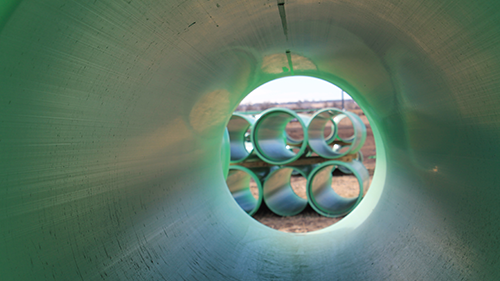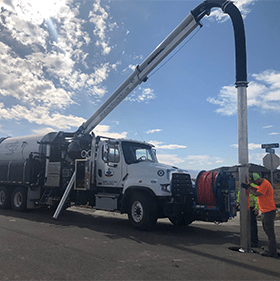Demystifying Wastewater Collections: What You Should Know

To many Boxelder Sanitation District customers, the business of wastewater collection is a bit like an iceberg; the majority goes unseen. With more than 100 miles of sewer lines comprising much of the District’s infrastructure—and considering the nature of the water before it goes through our updated wastewater treatment facility—it’s not surprising.
But despite the sequestered nature of wastewater collection and treatment, we at the District place a high value on nurturing active partnerships with our customers, which is why we strive for education and transparency.
Our primary responsibility is to clean wastewater and return it safely to the environment. In fact, our treatment plant has been recognized by the Environmental Protection Agency for its efficient and effective ability to treat the District’s wastewater. This is a group effort, which includes our Board of Directors, responsible maintenance of aging infrastructure, and educated customers like you—to name a few.
In order to have an efficiently running system, it’s important that all stakeholders understand what role they play. If there’s a backup, who’s responsible? The customer or the District? It all depends (more on that later!).
Before we dive into the details of wastewater collection, let’s take a high-level look at the District.
Founded in 1965, Boxelder Sanitation District totals more than 10-plus miles of sewer lines that lead to our wastewater treatment facility, which was expanded in 2021. Just shy of 2 million gallons of wastewater is processed every single day, which totals more than 700 million gallons a year. That’s a lot of wastewater!
District customers are divided into two segments, each with its own billing and regulations: residential and commercial.
Regardless of what type of customer is producing wastewater, it all leads to our treatment facility and, after it’s cleaned and processed, back into our region’s waterways.

Once you flush your toilet, the journey of that wastewater might seem like a bit of a mystery. But trust us when we say that journey is a wild one, with twists and turns along the way. We know that because we’ve traversed every inch of that journey.
Wastewater collections is a vital element of our system. It’s how we collect wastewater from our customers and transport it to our treatment plant so it can be treated and returned to the environment. Boxelder Sanitation District’s wastewater collections division consists of four dedicated team members who oversee 104 miles of gravity-fed lines and everything else along the way. That includes five main interceptors (interceptors are main sewer lines that receive wastewater from collector sewers), six lift stations (which help wastewater move over inclines in landscape) and exactly 2,294 manholes (we’ve counted!). And because residents use drains and toilets around the clock, we work around the clock, too.
We like to make sure the flow of wastewater through miles of pipes is…well…regular. That’s why our Wastewater Collections division has their own dedicated fleet and gear to ensure safe and secure collections. The vac truck, jet truck and water truck handle the messy business, while the camera van gives us eyes inside the pipes.
The District also has eight new flow meters. Permanent flow meters are located in the main five interceptors, plus one in the Timnath Lift Station. We also have two portable meters for on-the-go monitoring. These new meters allow the District to access real-time data, create flow graphs during big rain events, and reference accurate data to assist in our collection system masterplan.
After the long but swift journey through pipes, your wastewater finally arrives at the treatment facility’s screening system. Getting wastewater to the facility is a HUGE undertaking, and just as important as the cleaning that happens in our facility.
It’s a lot of work, but we love doing it! So, that’s our part…now what about your part?
The main responsibility residential customers have—and it’s a big one—is to adhere to the Do Not Flush list. This goes a very long way in keeping the District infrastructure clean and happy, and to prevent backups in your home. But what happens if a backup should occur?
Call us! The District is more than happy to visit and check the main sewer line to determine the problem and next steps—however there is some fine print you should know about.

The pipes that carry waste from your home to the District’s main sewer line is known as a service line (aka lateral sewer) and that section is the property owner’s responsibility. The majority of backups occur in the service line, which the homeowner is responsible for maintaining.
Many of our customers are surprised, however, to learn that not all homeowners’ insurance policies cover costs incurred to service lines backing up into the home. This can potentially cause several thousand dollars of damage, so please review your policy to ensure you’re knowledgeable about what is, and isn’t, covered.
Of course, we consider ourselves engaged partners in our relationships with customers, which is why we go to great lengths to ensure infrastructure after the service line is constantly maintained and repaired. Read all about our infrastructure management and upkeep in this blog.
Unlike residential customers, the District’s commercial customers have to follow a strict set of EPA guidelines before introducing their wastewater into our system. This ensures that the water is in a condition to be treated by our facility. This step is called pretreatment and the requirements vary depending on the type of business and operation.
The District currently works with 730 commercial businesses. These businesses include restaurants, breweries, manufacturing, marijuana dispensaries, auto repair, retail, offices and more. Within those 730 businesses, there are 30 different types of industry—from metal finishing to lab testing. So, you can imagine the range of contaminants that need to be filtered out before wastewater reaches the main sewer line.
Boxelder works with businesses to determine the type of pretreatment that needs to be completed. For instance, restaurants need to adhere to FOG standards, while metal finishing requires a different set of guidelines. Each business is responsible for purchasing and installing the required equipment for pretreatment, but the District is always willing and able to consult as a partner in the process.
Yes! Another major difference worth noting here is billing. Residential customers are charged a flat rate, which is determined based on winter averages. Commercial customers, however, are charged based on monthly usage.
To help our commercial customers with overall operational costs, we recently started an Irrigation Meter Program. From March 1 through November 30, non-residential customers may be eligible to benefit from participating in the Irrigation Meter Program for the measurement of the non-wastewater flows during this time period. Facilities with a minimum of 1,000 sq. ft. of irrigated property, or non-discharge activities such as evaporative cooling systems may apply for an “irrigation” or sub-meter to measure non-discharge consumption. Contact us to learn more!
We encourage customers to educate themselves about the wastewater collection process, the role they play in the process, and how they can best set themselves up for smooth, uninterrupted services. For more, peruse the FAQ section of our website, and don’t hesitate to reach out with any questions.
